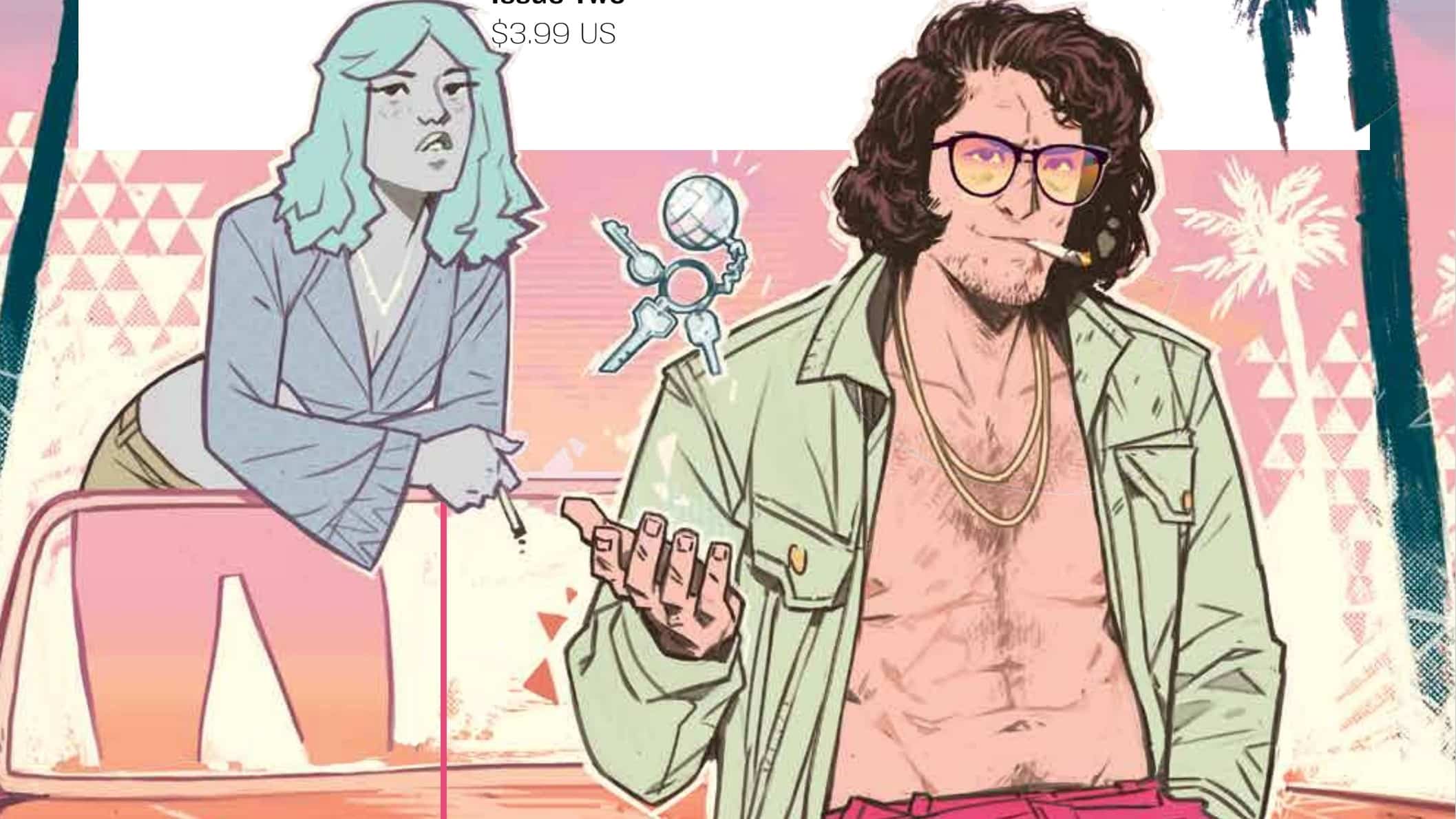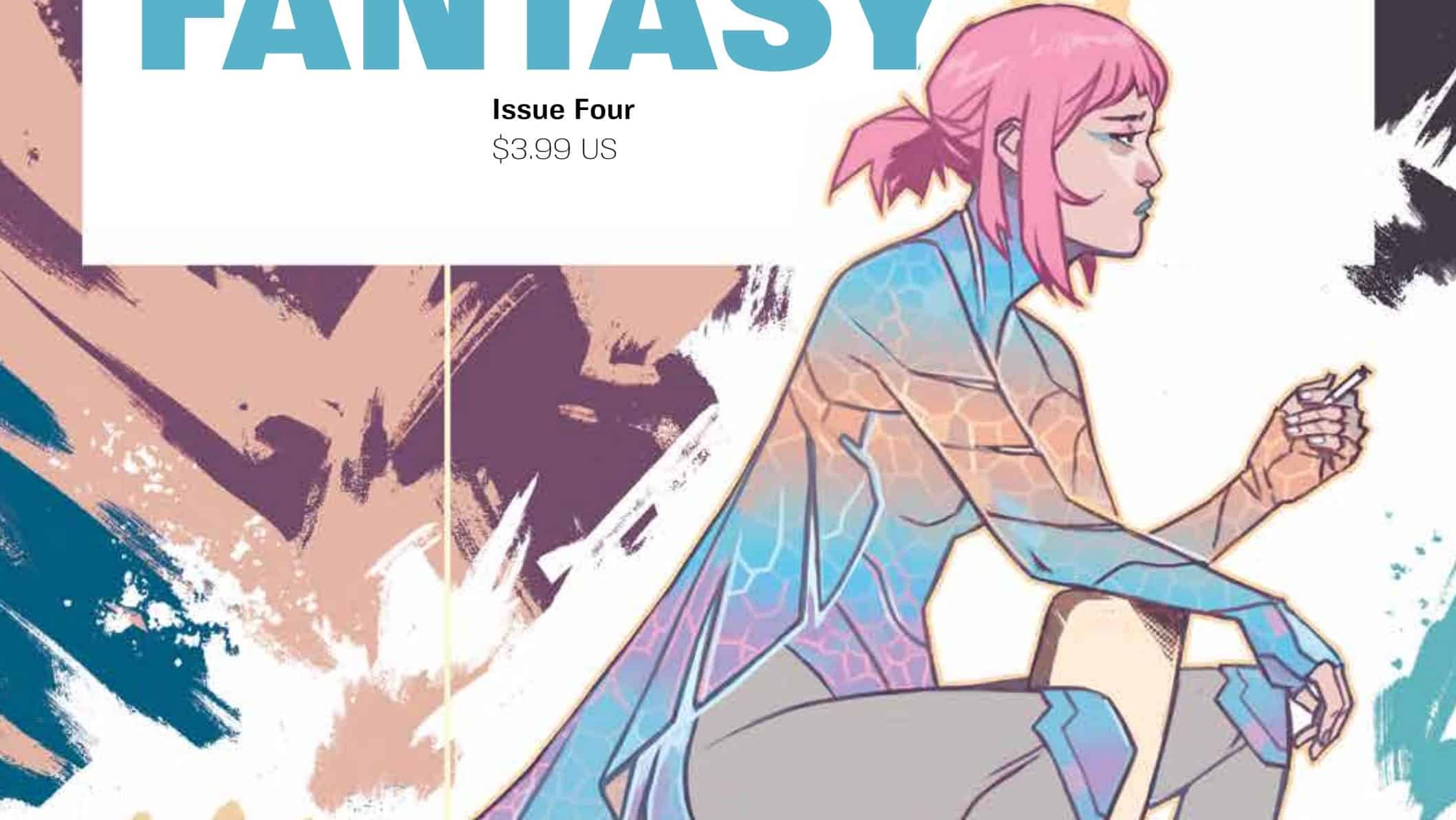Tension builds in the Cold War between the Atomics in the fallout to Etienne’s retaliatory strike, even as Brother Heavy reveals a secret which threatens to destabilize the détente even further in The Power Fantasy #2, written by Kieron Gillen, drawn by Caspar Wijngaard, lettered by Clayton Cowles and designed by Rian Hughes.
Sean Dillon: Hello and welcome to this month’s engagement with The Power Fantasy. This time, we deal with the aftermath of upending the entire political structure of the United States through very violent means, contemplating the implications of joining a cult, and a bunch of otakus going “I got that reference.”
Austin Gorton: Hold on, Sean, I need to go bring my secret adult child a beer inside his room-orb.
OK, I’m back. The Power Fantasy #2 is another richly layered issue, continuing the first issue‘s remarkable balance between intense character introspection and detailed worldbuilding. Let’s dive in!
State of the Union

Austin: The Power Fantasy #2 opens in the immediate aftermath of last issue’s attempted assassination of Heavy and the successful assassination of a large swath of U.S. leadership in retaliation. Yet it does so in its opening page by presenting a dialogue-free flashback to a previous assassination attempt on Heavy and the ensuing collateral damage in bystander deaths. What’s old is new, etc.
Sean: As often happens when a political assassination fails miserably, the response is abject violence and monstrosity, often with the more left-leaning people blamed for the act.
Austin: It’s a tension Gillen & Wijngaard explore throughout the issue, but it’s well-encapsulated in those opening panels, as a previous attack on the left-leaning Heavy from the right-wing government occurs at what appears to be an anti-war/anti-nuclear arms rally, with the violence begetting more violence that wouldn’t have happened if Heavy had been left alone.
Yet Gillen is also not without his humor; I love how this (pardon the pun) heavy situation is undercut by the gag of the newscasters urging viewers to keep their eyes peeled for Etienne just before Etienne casually strolls onto the set, coffee in hand, a “Whom, me?” look on his face.
Sean: Ultimately relaying that things could be a lot worse if this turn of events didn’t occur isn’t saying much. It’s ultimately a power move on the part of those with the most, flexing with the strength one typically is required to do with a first issue. The comedy is ultimately barbed with the horror of the situation (note how Wijngaard contrasts the initial image of Etienne stammering his way through a confession with the polish of a television screen with the murkier backdrop of the state of affairs the world finds itself in).
Austin: The theme of using the threat of violence to deter violence (ie “mutually assured destruction”) runs through the issue (and the series thus far), and while Gillen doesn’t hang a lampshade on it in these opening pages, it’s there nevertheless. On the surface, everything Etienne is saying seems reasonable. His actions were the best bad option; to have done otherwise would have invited even more death, and anyone looking to escalate the situation further should stand down as a result. Yet all that is undermined by the power Etienne is displaying by delivering the message. Intentional on his part or not, there’s an implied “or else” to his statement that suggests no one actually has free will in this matter.
Fight the Power

Austin: Another way Etienne’s sheer power is quietly expressed comes in the “jail escape” sequence, as he casually frees Tonya from her detention by freezing the cops’ minds, disabling their security cameras/psychic alarms (that are mostly for show anyway) and promising to stage it like he kidnapped her. It’s just the ease with which he does all this that highlights his power, it’s how little cares about being blamed for any of it.
Sean: An interesting aspect of this scene is the notion of the police being casually murdered by the Superpowers. It’s not whether this is actually happening, be it Magus or Valentina or whoever is doing it. Hell, it could be Etienne himself or just a coincidence. Rather, what’s interesting is the implication of its possibility.
Austin: The casualness with which Etienne, again, casts aside Tonya’s concern that someone might link the rise in police strokes to him (or another Atomic) is another example of his extreme “soft” power; he’s simply too big to fail, so to speak. There’s also a fun bit of worldbuilding here, as it’s revealed that the psychic alarms given to the police by the Forge-like Magus are just for show, with backdoors built in that allow Etienne to do his thing. Even when the Atomics are seemingly helping “the establishment,” they’re not ceding their power.
Sean: But more interesting is the presence of Morishita Masumi. In many regards a familiar face within comics about superpowers: one for whom the powers are a curse. In most straight-laced capes fare, these figures have ranged from Ben Grimm to Peter Parker to Anna Marie LeBeau. Figures whose powers lead them to be isolated, but nevertheless heroic.
But Masumi is very much someone who is mortified by her power. There are no possibilities for heroism when your brain is a void from which no light escapes.
Austin: I’ll admit: I bumped up against Masumi a bit here. As you say, her “type” is very familiar, part of a grand comic book tradition. But I’m struggling to connect with her outside that. Some of this, I’m sure, will come in time. It’s still not sure where she fits into this hierarchy and what her role in the plot is meant to be (aside from really wanting a gallery show). But I’m sure that’ll come in time.
I do really dig the version of Jimmy Olsen’s signal watch that she and Etienne have worked out for when she needs to get his psychic attention.
Sean: If I’m being honest, I think this is a bit of a weak issue overall. There’s a degree to which, like a lot of Gillen second issues now that I think about it, we’re seeing a bunch of chess pieces being put into place. We’re introduced to some elements here and there that will have a lot of importance and implications. But by and large, we’re just being introduced to them and having their implications be made clear rather than truly engage with the implications therein.
Louder Than a Bomb

Sean: And nowhere is this clearer than with the final-page reveal. We see that there’s a new Atomic being, Heavy’s kid, and this could result in a radical shift in the balance of things. But the full extent to which this changes things (other than a new thing existing) isn’t completely clear. Yes, the Akira reference is quite blatant, but what does this mean in the context of the world? We’ve seen new Atomics throughout the world outside of Heavy’s cult. Is there something that prevents Superpowers from procreating? Why is he special? The answer seems to be “Tune in next time! Same Power time! Same Power channel!” Which might be well and good when this is all collected, but right now it feels a bit thin.
Austin: I’m with you here. The thing that made it clear the last-page reveal was meant to be a big deal is the fact that it was a last-page reveal. Outside of its placement in the chronological flow of pages, we haven’t really gotten anything yet that establishes WHY Heavy having a flame-haired Sk8ter Boi offspring locked away in a floating orb is worthy of a last-page reveal.
Again, as with Masumi, I’m sure this will come in time. But for now, when looking at this issue as a discrete narrative element, connected to others but standing on its own, it’s a little thin. Lots of setup, lots of reinforcing themes and ideas from issue #1 (like the old adage about the second episode of a TV series having to function like a second pilot). The stuff I enjoyed the most was the small worldbuilding details on the margins: Magus’ police scanners, Masumi’s code-phrase, the hints at backstory.
Sean: It’s not bad, it’s just weak.
Fantasizing About Power
- Gillen takes a page from his time in the Krakoa era X-office and continues to use data pages for exposition (and, here, as the credits page as well, which is smart). This issue we get an abbreviated dramatis personae of some of the major players and how they relate to each other cosmologically.
- The fact that the symbol for Atomics on the data page (replicated in the image of Heavy’s son’s orb when its door opens) is a computer power button is some next-level punnery from the pun-loving Gillen.
- To be less harsh on the book, Wijngaard is killing it. Like, holy shit the use of contrasting styles of shadows when Masumi and Etienne talk about her brain. Just brilliant stuff all around.
- That five-panel sequence is astonishing. The coloring all throughout the issue deserves mention, the shifting pastels and the way Wijngaard uses them to depict changes in light and focus.
- Heavy is very much a cult leader who is quite open about being a cult leader.
- “We’re open about our weird sex stuff. We’re secret about our secrets” is a great line.
- And yet, we don’t really have a sense of the nature of his cult beyond “It’s full of Atomics.”
- Gillen’s end-of-issue letter is as charming and revealing about the nature of the book as you’d expect.
- Also, while we have you here, Kieron, what did you think about The Black Locomotive? I just finished it last night, and found it to be quite enriching. And that’s before you get to the use of fonts as a means of expressing perspective.
Buy The Power Fantasy #2 here. (Disclaimer: As an Amazon Associate, ComicsXF may earn from qualifying purchases.)





